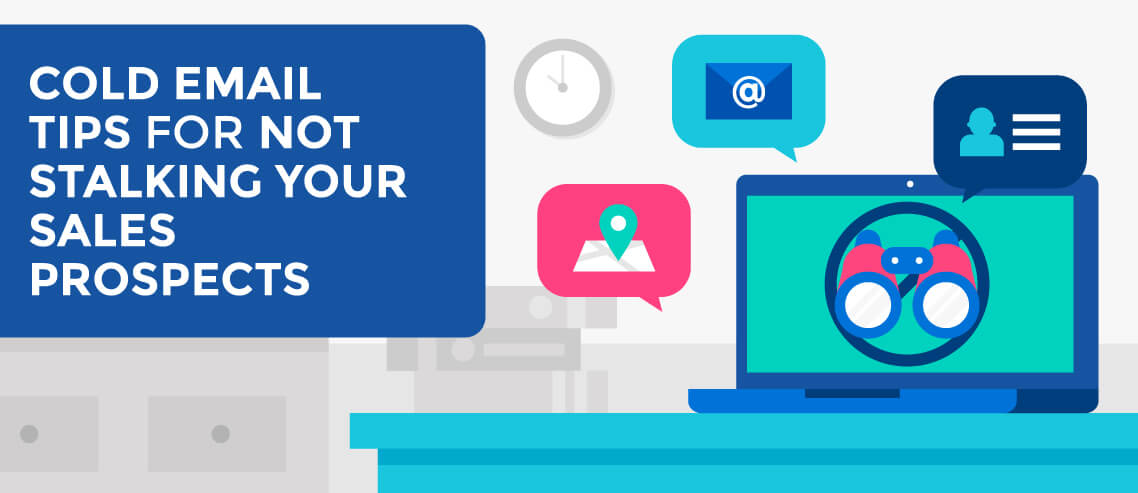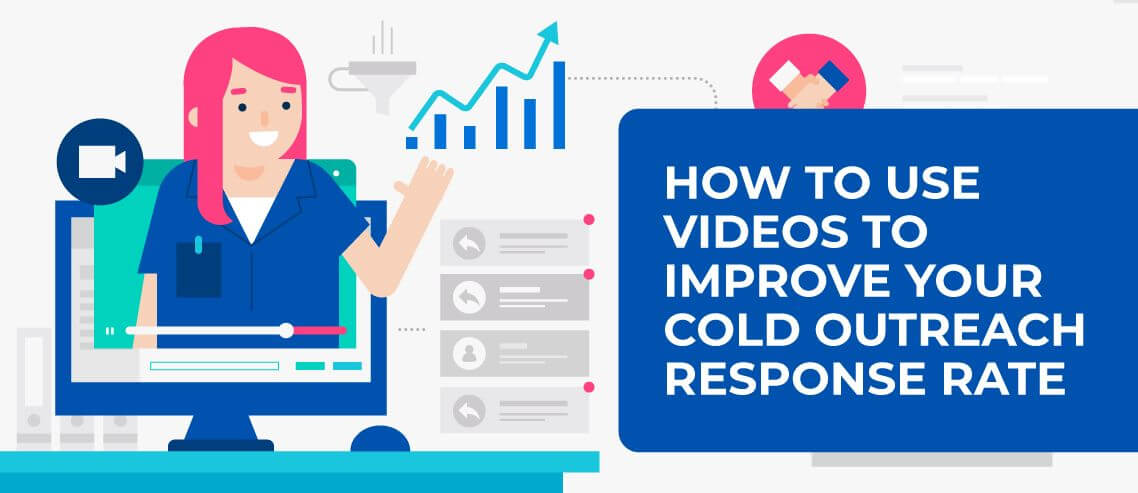9 Email Template Tweaks to Start Testing Today

Contents
Email templates – templated text that you edit part of in line with each individual recipient – help you send more emails in less time. They allow you to simulate the effect of a personalized email without having to craft a fresh email for each new recipient.
But that’s not all they can do.
Email templates also allow you to perform split tests that, over time, can help you optimize your templates so can enjoy increasingly better results (i.e. higher open rates and more replies) down the line.
If that sounds like something you want, here are 9 email template tweaks you can start testing today.
1. Add your recipient’s company name to the subject line
A popular subject line hack is to include your recipient’s name in the subject line. While I don’t doubt that this was once effective, today’s evidence suggests it now offers diminishing returns.
This is something Iris Shoor discovered when testing email templates for Oribi. The company’s A/B tests showed little difference in response rates between emails with and without the recipient’s name in the subject line. Shoor puts this down to the fact “everybody is using this method today and people don’t associate it with personal emails any longer.”
What they did find though is that adding the recipient’s company name to subject lines made a huge difference to both open and reply rates. They actually found that this little tweak resulted in most of their emails being opened and getting replies.
2. Write your subject line in lower case
If you currently write subject lines in title case, try writing the whole thing in lowercase – something James Scherer at Wishpond found improved both open and reply rates.
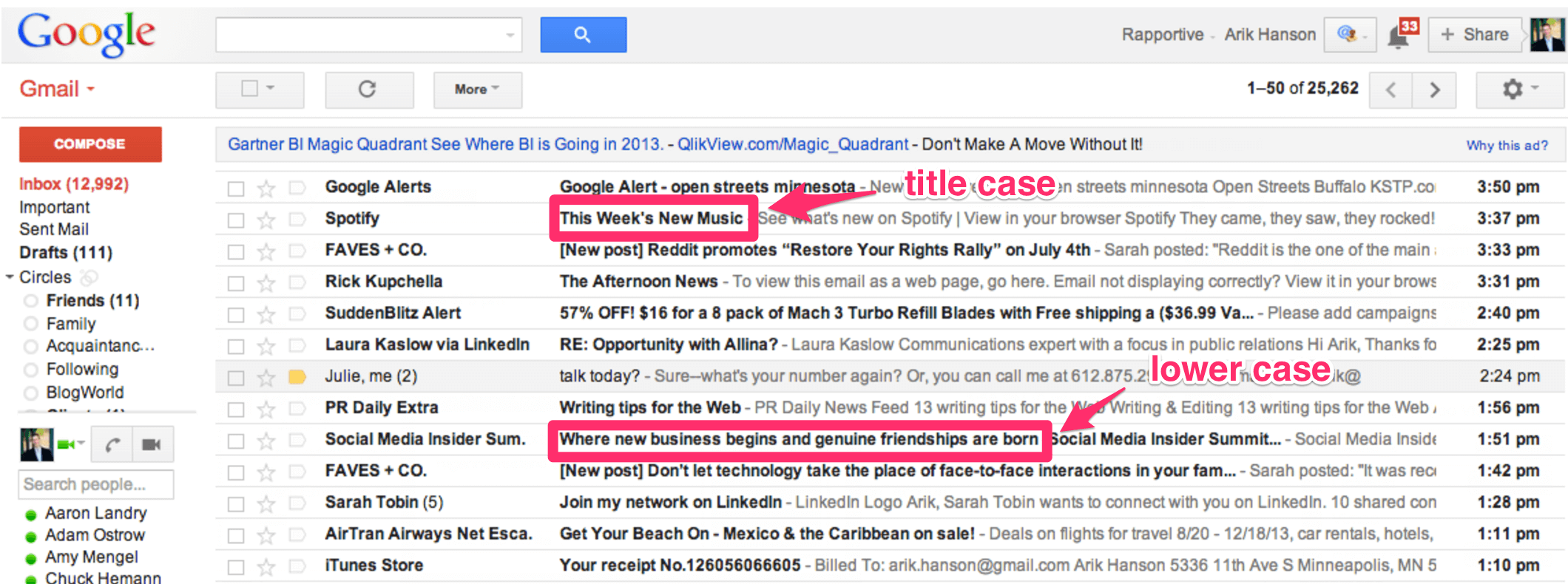
The jury’s out on exactly why this works, but chances are it’s because it feels more natural. It looks more like an email from a friend than a business, so we’re naturally going to be more inclined to click “open”.
3. Include an image
Most email pitches (that I’ve sent and seen, at least) are text only. That’s fine, and some people would probably tell you it’s best practice.
Depending on what you’re emailing about however, a single image (single being the operative word) could really help support your argument.
Let’s say you’re promoting an infographic, a poster, a report or some form of visual content. Why wouldn’t you show off the design by including a sneak preview image?
You could also test this out if you’re promoting a new tool. Just include a screenshot that highlights its best features and see what kind of response you get. Venngage’s poster maker offers lots of easy-to-edit templates to choose from, if this is a strategy you decide to utilize.
4. Try the Before-After-Bridge (BAB) Format
Yesware describes the BAB format like this:
- Before – Here’s your world now
- After – Imagine what the world would be like if you solved this problem
- Bridge – Here’s how to get there
What this means is that you describe a problem that’s common to your target audience. You then describe what their world would be like if they solved that problem. You wrap up by explaining how your product or service could help them realize this world.
Supposedly, this structure works due to the pleasure principle – the fact humans are motivated to act primarily by the possibility of pleasure and the avoidance of pain.
Here it is in action:
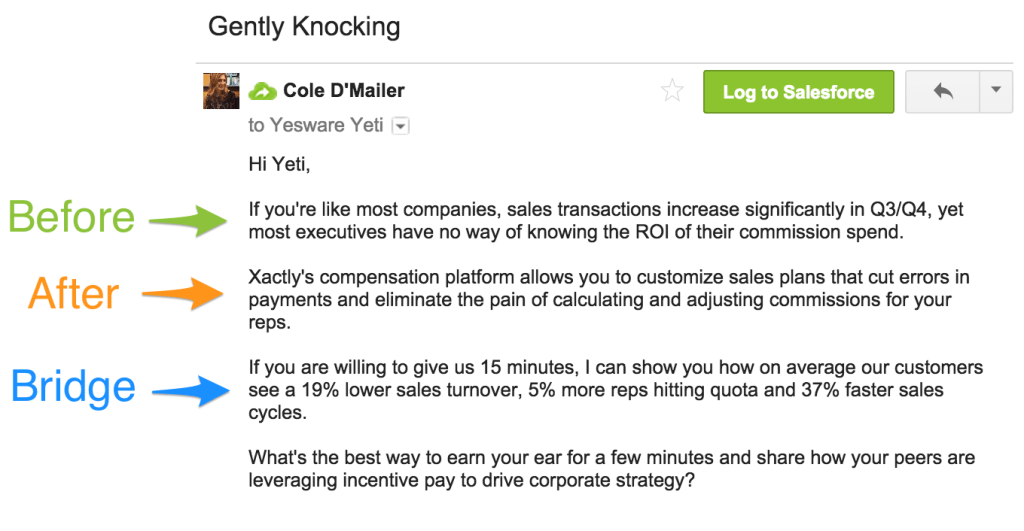
5. Offer a way out
This is another great idea I have to thank the guys at Yesware for (especially Bernie Reeder for writing the article in question).
This trick works on the basis that if you give someone a way out, they’ll be more likely to say yes. Twice as likely, to be precise – a theory that’s backed by 42 psychological studies on more than 22,000 people.
Yesware recommends stating what you want the recipient to do as a result of the email, and then politely saying it’s okay if they don’t want to. It can help to thank the recipient for their time, too. You can see what they mean here:
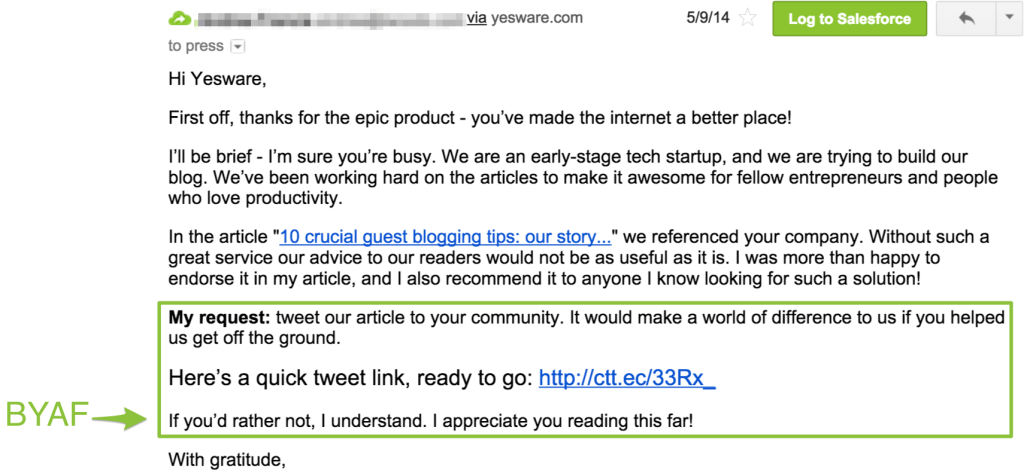
It’s certainly not the “hard close” of the BAB structure, but it’s one that clearly conveys respect for your readers’ time. This may be especially important if you’re dealing with sensitive audiences that resent being marketed to.
6. Change your signature
If you’re using an outreach tool (like Mailshake) you should be able to write a custom signature for your campaign – a different signature to the one that accompanies your usual emails.
In every case, an email signature needs to contain your company and contact details. This is critical if you want to be seen as established, professional and trustworthy.
They should, if possible, also match the style and tone of your email. That’s not going to be easy in everyday communications, as customizing every signature on every email you send would take too much time for too little reward.
Email campaigns, however, are different.
Writing a custom signature that matches the tone of your email could give your campaigns that edge. You could:
- Say something funny (if that’s in line with the tone used throughout the email).
- Feature links to content that’s relevant to the email and that your recipients might be interested in viewing.
- Try removing references to things like “marketing” that could change how you and your email are perceived.
7. Leverage FOMO
FOMO, or “fear of missing out,” is a common type of anxiety that results from thinking we’re missing out on something great. It’s the reason we might stick around at a party despite wanting to go home, or wander over to see what a crowd of people are looking at, even though we need to be somewhere else.
This anxiety is commonly exploited by marketers and advertisers. Whenever you see “limited time offer” or “only x available – when they’re gone, they’re gone” that’s someone trying to leverage FOMO and boost sales.

FOMO works in marketing because it drives us to make impulse purchases. It’s the key reason why daily deal sites like Groupon have done so well. In many cases offers will have both a time and volume limit attached to them. That means customers have no time to think things through – if they want it, they have to buy it now.
Unfortunately it’s unlikely you can be quite so dramatic in an email campaign. You risk coming off as desperate or sounding like you’re running a scam. What you can do is boost interest by creating scarcity or highlighting exclusivity.
Exactly how you do this will depend on the purpose of your email.
If you’re trying to promote a piece of content you could try saying something like:
“You’re one of the first people I’ve contacted about this so if you’re interested and get back to me quick, I can offer it you as an exclusive.”
When promoting a product or service, a limited-time discount is the most obvious way to leverage FOMO. This strategy is fine – if you word it correctly. Make sure to provide a genuine reason why the discount is time-limited, like this:
“Since this is early days we’re really looking for feedback as well as to grow our customer base. If you’re interested, and can promise to let me know what you think, I’d be happy to offer you access for half price (which you can have for life).”
8. Skip the introduction
Brevity is key to successful emails – especially cold email campaigns. Think about any times you’ve been cold emailed. You want to find out the reason for their email and what’s in it for you as quickly as possible.
“A good email should be short, concise, and contain only the most essential information. A wordy email laden with unnecessary backstory would be considered a bad one.” Corporate Media, On the Pulse
One way to speed up how fast you get to the point is to skip the introduction – the bit where you say who you are and where you’re from. At this point, the recipient probably doesn’t care. All they want to know is why you’re emailing – so jump straight into it.
If, after that, the recipient wants to know more, they can always check your signature. Test it, and see what happens.
9. Remove the main attraction from your email
Standard practice in email campaigns is to explain exactly why you’re emailing, and provide the recipient with everything they need to know, should they be interested in what you’re offering.
Instead, try holding back the main attraction.
If you’re promoting a piece of content, describe it, and ask if the recipient would like to see more. If you’re promoting a product, tell them about it, and then state that you can offer them an excellent deal. They just need to let you know they’re interested.
It’s a strategy supported by Matthew Barby in his article “Crafting the Perfect Email Pitch”.
“Never send over the content in the pitch email. Wait until you’ve had the go ahead from them.”
Of course, despite Barby’s confidence that this is the right way to do outreach, in reality there’s no guarantee that this will work for you. Still, you can increase your odds of the test paying off by ensuring your content or offer matches your description of it. Don’t disappoint your prospects by getting them excited and letting them down at the final hurdle.
Image sources: arikhanson.com, List It Quick


